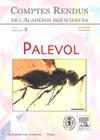从中世纪旧石器时代的Bois de l ' hopital遗址(Saint-Sulpice-la-Pointe, Tarn)发射的用于打击乐器的成型工具
IF 1.3
4区 地球科学
Q3 PALEONTOLOGY
引用次数: 2
摘要
2015年11月至2016年4月(Bernard-Guelle et al. 2016),对Bois de l 'Hôpital遗址(法国塔恩省saint -叙尔皮斯-la- pointe)进行了预防性考古发掘,发现了几个可追溯到上更新世的考古层,这些考古层位于塔恩河下游河谷旧石器时代中期前所未有的原始环境中。主层(考古单位UA3)显示了一个主要以石英(有时是石英岩或燧石)为原料的石制工业,与莫斯特技术综合体有关。作为铁砧盘和勒瓦卢瓦破坏技术的产物,由薄片(主要是刮刀和齿状)制成的工具与卵石工具共存。很少有详细研究的主题——特别是在莫斯特收藏中——描述了卵石工具的操作链(cha本文章由计算机程序翻译,如有差异,请以英文原文为准。
L’outillage façonné utilisé en percussion lancée du site paléolithique moyen du Bois de l’Hôpital (Saint-Sulpice-la-Pointe, Tarn)
The preventive archaeological excavation of the Bois de l’Hôpital site (Saint-Sulpice-la-Pointe, Tarn, France), between November 2015 and April 2016 (Bernard-Guelle et al. 2016), uncovered several archaeological layers dating back to the Upper Pleistocene set in an unprecedented/original context for the Tarn’s lower valley’s Middle Paleolithic. The main level (archeological unit UA3) displays a lithic industry mainly manufactured on quartz, sometimes quartzite or flint, related to a Mousterian technological complex. The product of anvil discoid and Levallois debitage technique, the tools made from flakes (mostly scrapers and denticulates) coexist with pebble tools. Rarely the subject of a detailed study – particularly in Mousterian collections – the pebble tools’ operating chain (chaîne opératoire) has been described, functional purposes included. This technological, morphological and functional analysis identifies several tool groups and is able to link some of them to specific mode of action on material, comparing them with an experimental data repository. The study of the macro-tools from archaeological unit UA3 emphasizes: 1) their high proportion among the tools; 2) an important structural variety among those specific tools; and that 3) most of them are consistent with a cast percussion motion, possibly related to bone-fracturing process. These results prompt us to continue developing the technological and morphological analysis of those tools, whose inherited or reinvested (compared to Lower Paleolithic technological complexes) or alleged functions seem to result in a lack of interest from the researchers. They call for the collection of more experimental data repositories in order to compare other quartz and quartzite macro-tools sets, often described in the Tarn basin during MIS5 and MIS3.
求助全文
通过发布文献求助,成功后即可免费获取论文全文。
去求助
来源期刊

Comptes Rendus Palevol
地学-古生物学
CiteScore
2.10
自引率
0.00%
发文量
39
审稿时长
17.6 weeks
期刊介绍:
Comptes Rendus Palevol is a fully electronic and peer-reviewed journal, with a continuous publication stream, devoted to palaeontology, prehistory and evolutionary sciences. It publishes original research results, in French or English, in the following domains: systematic and human palaeontology, prehistory, evolutionary biology and macroevolution, and history of sciences. Thematic issues may also be published under the responsibility of a guest editor. All articles published in Comptes Rendus Palevol are compliant with the different nomenclatural codes. A copyright assignment will be signed by the authors before publication.
 求助内容:
求助内容: 应助结果提醒方式:
应助结果提醒方式:


